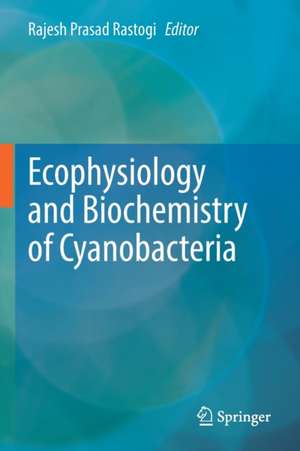Ecophysiology and Biochemistry of Cyanobacteria
Editat de Rajesh Prasad Rastogien Limba Engleză Paperback – feb 2023
The contents incorporated in this book can be used as a textbook by undergraduate and post-graduate students, teachers, and researchers in the most interesting fields of physicochemical ecology and biochemistry of cyanobacteria.
Toate formatele și edițiile
| Toate formatele și edițiile | Preț | Express |
|---|---|---|
| Paperback (1) | 1117.34 lei 6-8 săpt. | |
| Springer Nature Singapore – feb 2023 | 1117.34 lei 6-8 săpt. | |
| Hardback (1) | 1123.50 lei 6-8 săpt. | |
| Springer Nature Singapore – 31 ian 2022 | 1123.50 lei 6-8 săpt. |
Preț: 1117.34 lei
Preț vechi: 1362.61 lei
-18% Nou
Puncte Express: 1676
Preț estimativ în valută:
213.80€ • 223.83$ • 176.91£
213.80€ • 223.83$ • 176.91£
Carte tipărită la comandă
Livrare economică 07-21 aprilie
Preluare comenzi: 021 569.72.76
Specificații
ISBN-13: 9789811648755
ISBN-10: 9811648751
Pagini: 478
Ilustrații: XVI, 478 p. 1 illus.
Dimensiuni: 155 x 235 mm
Greutate: 0.69 kg
Ediția:1st ed. 2021
Editura: Springer Nature Singapore
Colecția Springer
Locul publicării:Singapore, Singapore
ISBN-10: 9811648751
Pagini: 478
Ilustrații: XVI, 478 p. 1 illus.
Dimensiuni: 155 x 235 mm
Greutate: 0.69 kg
Ediția:1st ed. 2021
Editura: Springer Nature Singapore
Colecția Springer
Locul publicării:Singapore, Singapore
Cuprins
Chapter 1. Evolution and distribution of Cyanobacteria.- Chapter 2. Polyphasic approach and cyanobacterial taxonomy: Some perspectives and case studies.- Chapter 3. Photosynthesis and energy flow in cyanobacteria.- Chapter 4. Impacts of environmental stress on physiology and biochemistry of cyanobacteria.- Chapter 5. Photosynthesis under abiotic stress.- Chapter 6. UV stress responses in cyanobacteria.- Chapter 7. Molecular mechanisms of stress tolerance in cyanobacteria.- Chapter 8. Stress proteins and signal transduction in cyanobacteria.- Chapter 9. Evolution and diversification of the GroEL/chaperonin paralogs in cyanobacteria. Chapter 10. Chromatic Acclimation in Cyanobacteria: Photomorphogenesis in Response to Light Quality.- Chapter 11. Phenomenon of allelopathy in cyanobacteria.- Chapter 12. Toxicology of cyanobacteria.- Chapter 13. Nitrogen metabolism in cyanobacteria.- Chapter 14. Phycoremediation of wastewater.- Chapter 15. Environmental resilience and circular agronomy using cyanobacteria grown in wastewater and supplemented with industrial flue gas mitigation.- Chapter 16. Antioxidant, anti-aging and anti-neurodegenerative biomolecules from cyanobacteria.- Chapter 17. Engineering challenges of carbon dioxide capture and sequestration by cyanobacteria.- Chapter 18. Engineering cyanobacteria cell factories for photosynthetic production of sucrose.- Chapter 19. Optimal biomass production by cyanobacteria, mathematical evaluation and improvements in the light of bio-refinery concept.- Chapter 20. Cyanobacteria as renewable sources of bio-energy (Bio-hydrogen, Bio-ethanol and Bio-oil production).- Chapter 21. Cyanobacteria as a competing source of bioenergy: metabolic engineering and modeling approach for medium optimization.
Notă biografică
Dr. Rajesh Prasad Rastogi is a scientist in the Ministry of Environment, Forest and Climate Change, New Delhi, India. He completed his Ph. D. in Botany at Banaras Hindu University, Varanasi, India. Dr. Rastogi is the recipient of some national and international awards and fellowships. He was a visiting scientist at Friedrich Alexander University, Nuremberg, Germany and served as a visiting professor of biochemistry at Chulalongkorn University, Thailand. His major research areas are freshwater or marine algae and cyanobacterial ecology and biotechnology, plant physiology, photochemistry & photobiology and stress biology. He has published a number of research papers in journals of international repute and several book chapters and books, having more than 4000 citations with 30 h-index and 47 i10-index. He is serving as editorial board member of some national and international journals and is life member of several scientific organizations.
Textul de pe ultima copertă
This book emphasizes and presents the latest information on eco-physiology and biochemistry of cyanobacteria with special emphasis on their biodiversity, molecular mechanisms of some important biological processes and survival mechanisms under myriad of environmental conditions as well as bioremediation. Cyanobacteria are the most dominant prokaryotic floras on the Earth’s surface, and are of great importance in terms of ecological, economical and evolutionary perspectives. They are oldest groups of photosynthetic autotrophs, which create oxygenic atmosphere for the development and sustainability of ecosystems with different life forms. The book presents an integrative approach to their possible biotechnological application in the field of bio-energy and various aspects of biochemistry, biophysics and structural biology of photosynthesis. The various chapters describe the different applications of cyanobacteria as bio-energy sources and in phycoremediation.
The contents incorporated in this book can be used as a textbook by undergraduate and post-graduate students, teachers, and researchers in the most interesting fields of physicochemical ecology and biochemistry of cyanobacteria.
The contents incorporated in this book can be used as a textbook by undergraduate and post-graduate students, teachers, and researchers in the most interesting fields of physicochemical ecology and biochemistry of cyanobacteria.
Caracteristici
Discusses evolution, geographical distribution and taxonomy of cyanobacteria Describes carbon dioxide sequestration, UV and other stress response Includes self-explanatory colored images and informative tables
